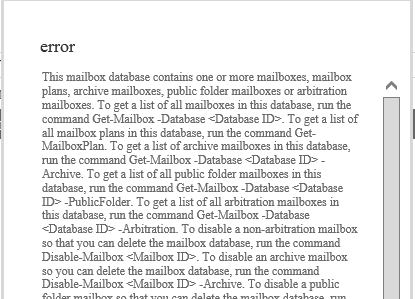Several
times when you attempt to remove a database from an MS Exchange Server 2013
mailbox, you may come across the following error:
“This
mailbox database contains one or more mailboxes, mailbox plans, archive
mailboxes, public folder mailboxes or arbitration mailboxes.”
You may note here this error occurs even on a brand new mailbox database
which you have not migrated any mailboxes to or created new mailboxes on is susceptible
to this type of error.
Below is the snapshot of this error:
This error message provides the following details:
a) Root cause- It is due to the mailboxes that
still exist on the database.
b) Resolution - It is achieved by removing the
mailboxes.
Now, let’s
take a glance at each of the mailboxes types and the required strategy to move
or remove them.
a) MAILBOX
USERS– For normal mailbox users, you need to runthe following command New- MoveRequest and wait for the moves
to complete. In this way mailbox users can be moved to another database.
E.g.To move the mailboxes from ‘Mailbox
Database A’ to ‘Mailbox Database B’ the following command is executed.
[PS] C:\>Get-Mailbox -Database
"Mailbox Database A" | New-MoveRequest -TargetDatabase "Mailbox
Database B"
b) ARCHIVE
MAILBOXES – In these type of
mailboxes, the default command provided(for removal) in the error message does
not actually work. So instead of this, you can run the following command
to identify mailboxes with the ArchiveDatabase attribute matching the database
that you are trying to remove.
[PS] C:\>Get-Mailbox | Where ArchiveDatabase
-eq "Mailbox Database P"
Name Alias ServerName ProhibitSendQuota
---- ---- ---------- --------------
Mark.Luther Mark.Luther e15mb1 Unlimited
Denis.Lilly Denis.Lilly e15mb1 Unlimited
To move
these archive mailboxes, you need to execute the following New- MoveRequest command
again.
[PS] C:\>Get-Mailbox | Where
ArchiveDatabase -eq "Mailbox Database P | New-MoveRequest -ArchiveOnly
-ArchiveTargetDatabase "Mailbox Database Q"
c) ARBITRATION
MAILBOXES– In Exchange Server 2013, this type of mailboxes serve many purposes
but generally they prevent the removal of the database on which they exist in.
To view the
arbitration mailboxes execute the Get-Mailbox
command as follows:
[PS] C:\>Get-Mailbox -Database "Mailbox
Database M"–Arbitration
Now,
arbitration mailboxes can be moved to another database similar to any other
mailbox move request.
[PS] C:\>Get-Mailbox -Database "Mailbox
Database M" -Arbitration | New-MoveRequest -TargetDatabase "Mailbox
Database N"
4 d) PUBLIC
FOLDER MAILBOXES - There is a special folder named ‘public folder
mailboxes’ in Exchange Server 2013 where public folder data is stored.
To check a
database for public folder mailboxes run the following command:
[PS] C:\>get-mailbox -Database "Mailbox
Database P"–PublicFolder
Now these
public folders can be moved by executing the following command:
[PS] C:\>Get-Mailbox -Database "Mailbox
Database P" -PublicFolder | New-MoveRequest -TargetDatabase "Mailbox
Database Q"
FINALLY REMOVING THE EXCHANGE SERVER 2013
DATABASE – After the removal of all mailboxes types from the database, you can
finally proceed to remove the database itself.
Now
navigate to Exchange Admin Center (EMC)-> Servers ->Databases, select the
database which you want to delete, and click the trash icon.
So make
sure that you have carefully identified and removed all the mailboxes because
this will ensure the successful removal of Exchange 2013 database.
